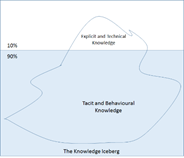In the previous couple of posts (see last post) on Managing the transition of Managed Services, we looked at a few issues that you have to consider when you are thinking of transitioning managed services to a new organisation -what are the key things to consider to ensure that the services you are transitioning are the right ones and also the factors to look for in the new organisation to ensure that they are the right organisation for you.
In this post we will look at how you can manage the knowledge management and knowledge transfer from the old organisation to the new.
Picture Source: imperial-consultants.co.uk
One of the key things to keep in mind is that the window for the transfer of knowledge is very small and you have to be fleet of foot to make sure that the available window is used usefully. It is important to put in place processes for this and execute and monitor this well.
As you are aware there are various types of knowledge:
Tacit and behavioural knowledge like
- Knowledge and experience of individuals (for example, undocumented behaviour and features of certain systems, habits of certain stakeholders that you can use to your advantage, undocumented organisational politics etc)
- Cultural practices and expectations (like, allowing time for prayer on Friday afternoons)
- Organisational practices and expectations (like, different financial year reckoning, reporting formats etc.)
Explicit and technical knowledge like
- Structural interactions (reviews, reporting etc.)
- Documents
- Code
The key thing is to identify the knowledge holders in the current organisation. Once identified, you need to put in place a process of knowledge transfer and motivate the current holder to facilitate the transfer. You need to get feedback from the new organisation about the efficacy of the transfer process and monitor the transfer process closely and make any necessary adjustments and corrections.
In my previous organisation we did transfer the maintenance and development of a set of software from one organisation to another to improve efficiency and save costs. One of the key hurdles we faced in the knowledge transfer process was that the transferring organisation was not keen on the transfer process and since we were cutting off our contract with them, they had no motivation to engage in the process. What really saved the day were two things: 1. we had fairly good documentation of the systems and 2. the new organisation had some excellent people who could carry the ball with the minimum of inputs. This shows it is always important to have up-to-date documentation of your systems.
This brings us to the challenges you would face in the process of knowledge transfer. Some of them are:
Geographic distance: this is a challenge in any situation. However, with current technologies, this abyss can be overcome to some extent.
Language: this is an obvious challenge, especially since many of the new organisations to which you are transferring the managed services may be to countries where your language may not be well-understood. Even though many of the managers in these organisations speak good English, some of the engineers may not understand the nuances of the language properly and hence miss out on or misinterpret (or misrepresent) important information.
Picture Source: commons.wikimedia.org
Union issues: these issues are best left to be tackled by HR, legal etc. You may not have the expertise or background to handle these issues.
Picture Source: cleanclothes.org
Motivational issues: the people of organisation from which you are transferring the services may not have the motivation to sit through a long transfer process. It may be important for you overcome these issues through some incentive mechanisms.
There are many other challenges like different cultures, capability, misconceptions etc. This is why your knowledge transfer process should be well thought out and executed with great care.
Techniques for knowledge transfer: What are some of the techniques you would use for this knowledge transfer. In our organisation we mainly used the technique of the representatives from the two organisations of corresponding functions sitting down and having discussion sessions with each other. These were supplemented by actual demos of systems, code-walkthroughs, simulations of the systems etc.
In addition there are techniques that you could use like work-shadowing, paired working and others.
These are some of the challenges you face in the process of knowledge transfer from the old organisation to the new organisation and some of the ways you can overcome them and ensure that the knowledge transfer happens properly.
In the next post in this series we will look at the interfaces you need to establish between the new organisation to your organisation and to other organisations and stakeholders





It says Howdy, Vasu Vasudev, as if I am rowdy.
Good article.
Ironic – Are you aware of this type of knowledge graphic is blurred, not able to read clearly even if I zoom.
It is taking 2* minutes to get a response of after clicking Post, so not posting any more.
*I timed it for last post.